Over 2,000 temples and shrines fill the city of Kyoto, Japan. It’s hard to stand out but Kinkakuji or the Golden Pavilion in the northwestern part of the city was unique and unforgettable. Here are our tips for visiting the Golden Pavilion in Kyoto.
This is a UNESCO World Heritage site and is one of the Buddhist temple’s main buildings. Its top two floors, completely covered in gold leaf, overlook a pond and surrounded by a beautiful garden, making it famous.
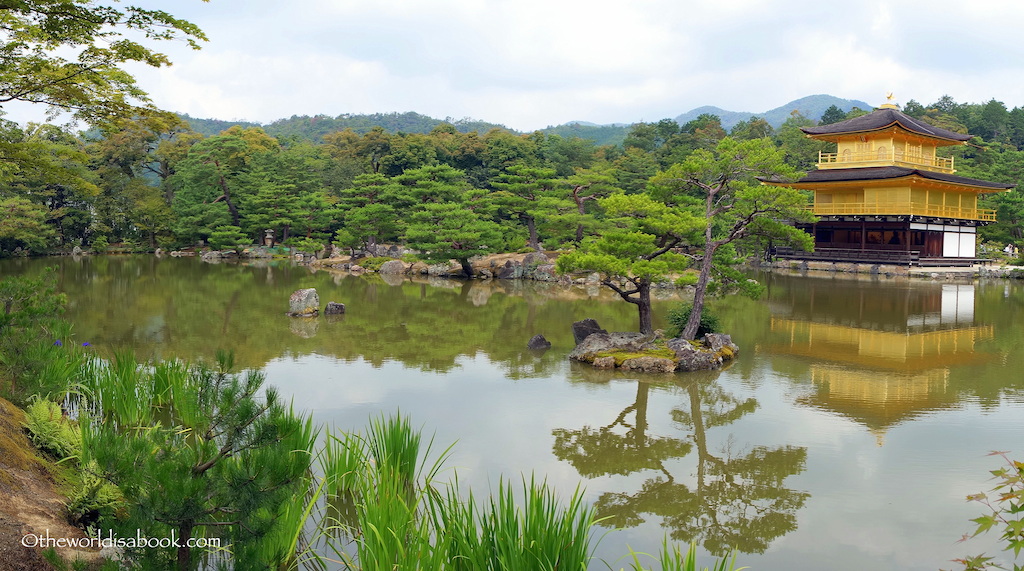
We were here on a hot and humid weekday morning during a late June visit. We walked through a quiet residential street leading to the complex in a nondescript entrance known as the First Gate.

It was quite busy with several tour groups and a ton of school children on field trips. After making our way past them, we found ourselves in a clearing that opened into the stunning Kinkakuji.
The temple was gleaming in the middle of the pond and its surrounding gardens. It was a true testament to the Japanese high standards of meticulously placed stones, and well-manicured plants and trees that blended perfectly.
It wasn’t a very large structure, which was a bit surprising to me. The pavilion stood at 42 feet (12.8 m) high and 33 feet (10 m) wide.

The pond, appropriately called Kyoko-chi (Mirror pond), had several small islands on it. We couldn’t stop taking pictures of its reflection on the calm pond and frankly, you can’t take a bad picture here. As we moved around the walkway, different viewpoints greeted us, and the islands and rocks took on different shapes.

It was such a contrast to an image of a Zen temple with gardens for serenity and meditation. You won’t get that tranquil setting here with hordes of tourists crowded in the walking paths all trying to pose or take a picture.
Though, it was perfectly understandable why this was such a crowded and popular attraction. We just learned to push our way in to capture some of these photos without the crowds.
History of Kinkakuji
Although this present structure was built in 1955, the original Kinkakuji dates back to its first structure in 1393 when it served as Shogun Yoshimitsu Ashikaga’s retirement villa.
His opulent lifestyle included intentions to cover this building’s exterior with gold but only got to covering the third floor ceiling.
His son turned it into a Zen temple and formally called Rokuon-ji or Deer Garden Temple after Ashikaga’s death. Many of Kyoto’s temples were actually first established as retirement villas.
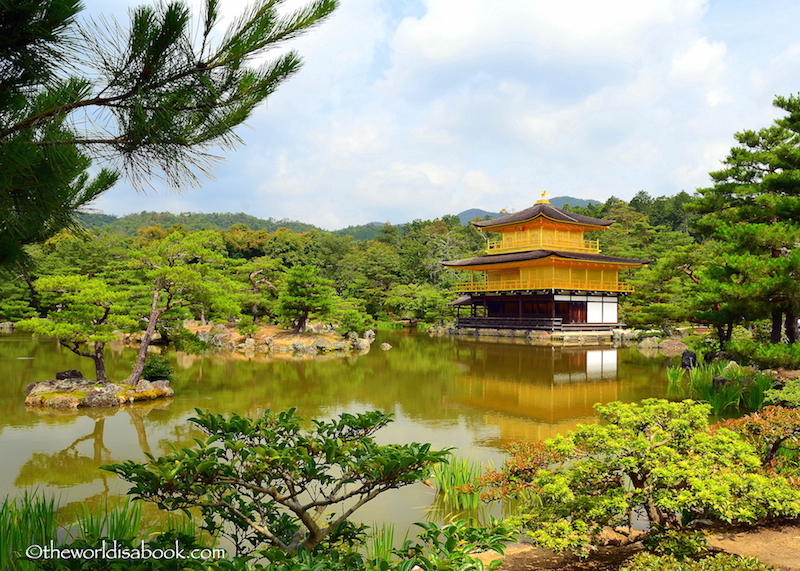
The Golden Pavilion structure was the only one left from that retirement complex. Unfortunately, it has burned down several times from wars and most recently in 1950 by a suicidal monk. The garden retained its former glory as a Japanese garden exuding beauty and symbolism despite the rebuild in 1955.
They made a decision to cover the top two floors in gold leaf to honor Ashikaga’s original plans, maintaining the original structure’s architecture. They covered the temple with even more gold leaf (5 times thicker than the original) in 1987. There were some clouds during our morning visit so it wasn’t as blinding as I would imagine it in the mid-afternoon with the sun shining brightly on it.

The Structure of Kinkakuji
Kinkakuji’s three floors feature varying architectural styles with surrounding balconies. Unfortunately, visitors cannot go inside the pavilion these days.
The first floor, known as Hôsuiin (Temple of Dharma Water), is the only one not covered in gold leaf. The wood pillars and plaster walls were Shinden style from the 11th-century Heian nobility period.
Since the front windows were open, we were able to zoom in and see some statues. One of the statues was supposed to depict the historical Buddha and the founder himself, Yoshimitsu Ashikaga.

The pavilion’s second and middle floor was one of the two covered on gold leaf and built in the Bukke style that was used for samurai houses and called Chôondô (Tower of Sound Waves). The interior was supposed to house more Buddha statues and the Four Heavenly Kings and some Buddha relics.
The pavilion’s second and middle floor, covered in gold leaf, was built in the Bukke style. They used them for samurai houses called Chôondô (Tower of Sound Waves). It was intended to house more Buddha statues like the Four Heavenly Kings, and some Buddha relics.

The top floor was supposed to be a Buddhist Zen Hall and known as Kukkyôchô (Superb Apex). Its interior and exterior were covered in gold leaf and seemed fancier than the bottom with its rounded windows.
The builders intended top floor, known as Kukkyôchô (Superb Apex), as a Buddhist Zen Hall. The designers covered its interior and exterior with gold leaf and appeared fancier than the bottom with its rounded windows. On the rooftop was a golden Chinese mythical phoenix, which probably stood for this structure rising from the ashes multiple times.
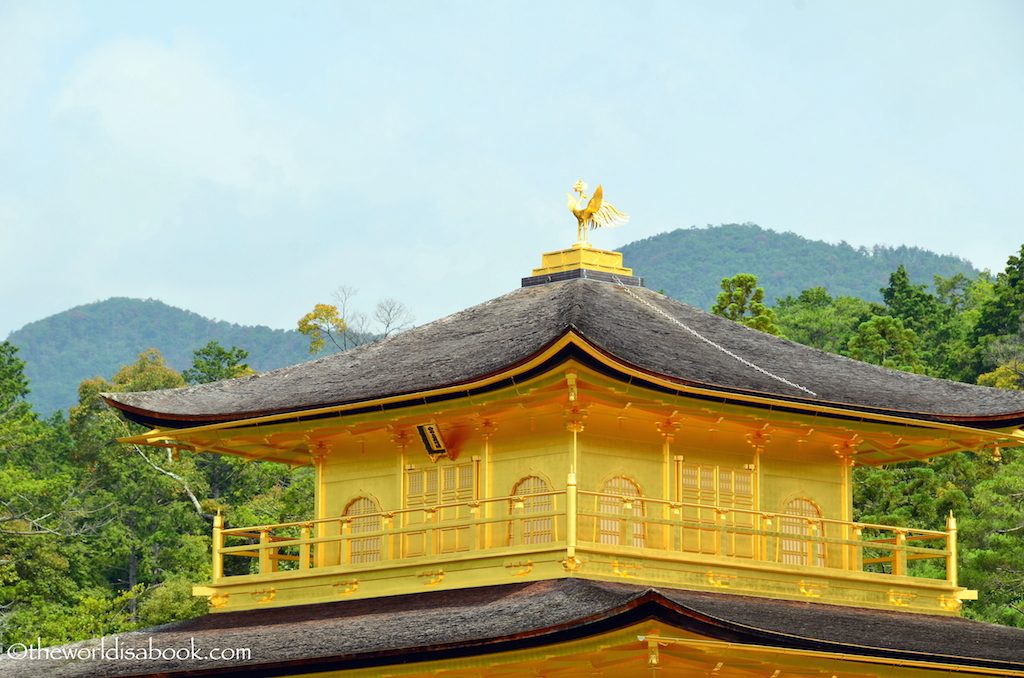
Golden Pavilion’s other attractions
While the Golden Pavilion was the star attraction here, there were also other structures around the area worth mentioning. Everyone goes through a one-way path that went behind the temple that led to a stairway to exit. It helped control the traffic.

Residence Structure
We passed by the hojo or the head priest’s former residence complex. It featured painted sliding doors and what appeared to be a sand garden. It did look so peaceful though and we could only imagine how it looked inside.
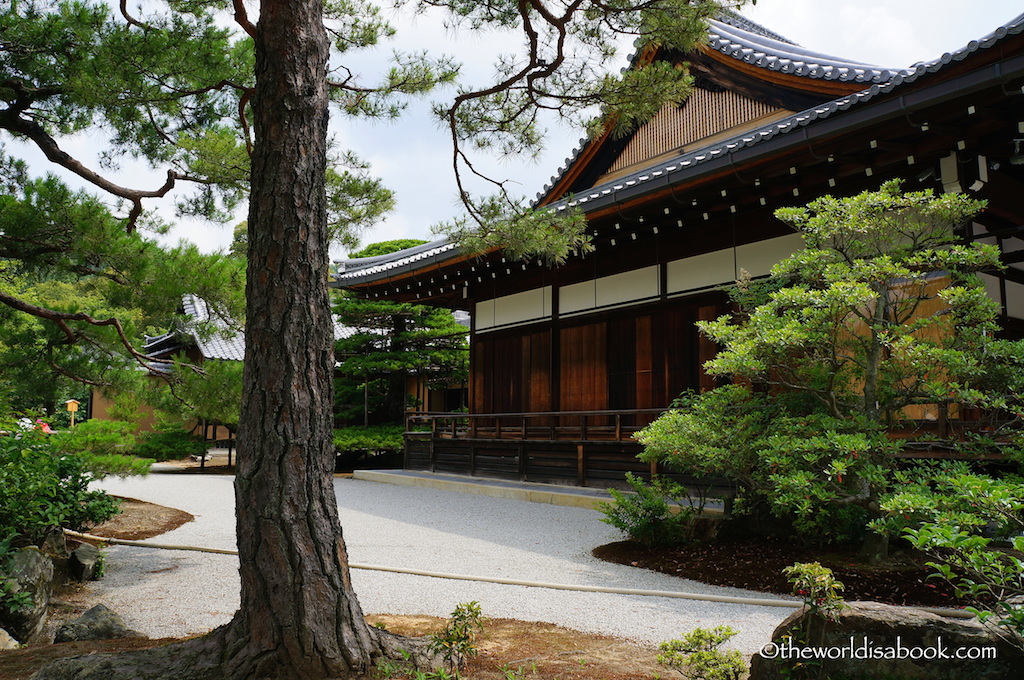
The back area of the pavilion gave us a closer look at the structure. From the back, we saw a small wooden patio that extended from it. We found plenty of carp (freshwater fish) here to entertain the kids.

An-min-taku Pond
In an almost hidden spot in the gardens was the small An-min-taku Pond which has never dried up. Hakuja-no-tsuka (white snake mound) was the island with a small stone pagoda standing on it. Images of the four Buddhas on its base adorned the pagoda. They dedicated the pagoda to the legendary white snake that supposedly controlled the ground’s water supply.
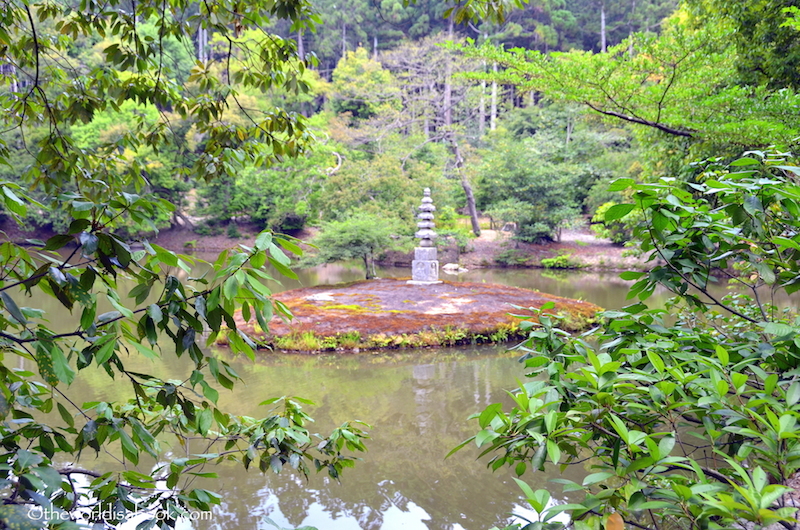
Along the garden path was a small waterfall (Ryūmon Taki waterfall). The water current falls on a Rigyo-seki or carp stone meant to resemble a carp swimming upstream and symbolizing strength.

See Stone Carvings
We found this small collection of stone carvings where everyone threw coins in for good luck. Of course, my kids tried it. Though, it felt more like those carnival games where you’re trying to toss rings into bottlenecks.
We weren’t exactly sure if the bowls were the targets. But, we just followed the other kids who seemed to be aiming for them.
This was a popular spot for the students. Who says temples can’t be fun for kids?
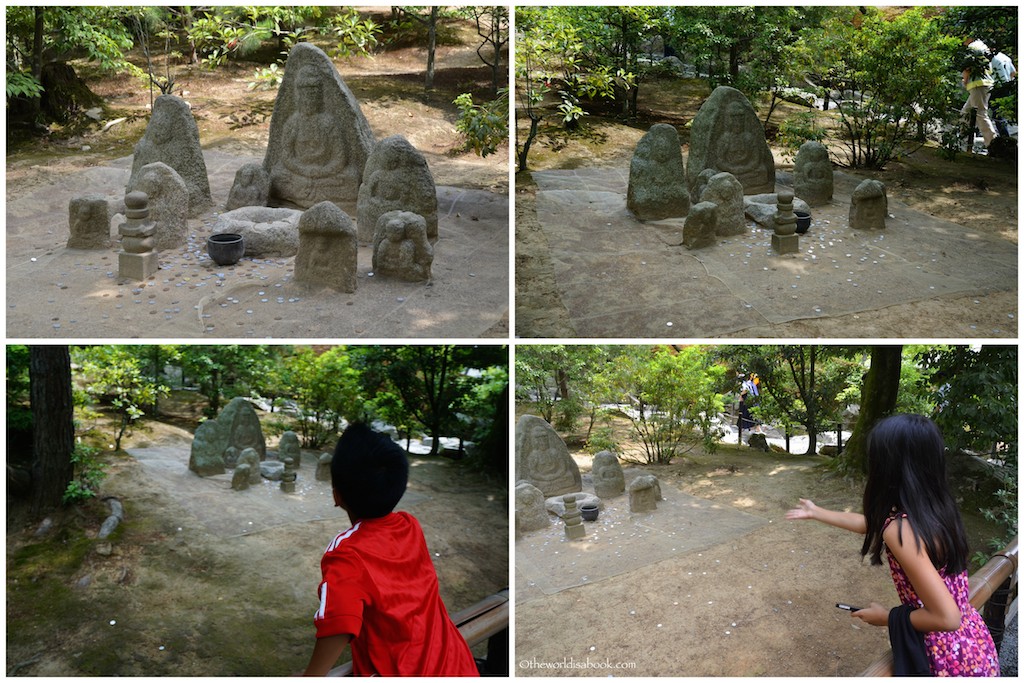
The Tea House
At the top of the hill stood the small Sekka-tei Teahouse rebuilt in 1884 after a fire. Compared to the other structures here, this teahouse was very simple and lacked color. Its simplicity aimed to emphasize the importance of the tea ceremony rather than the building itself.
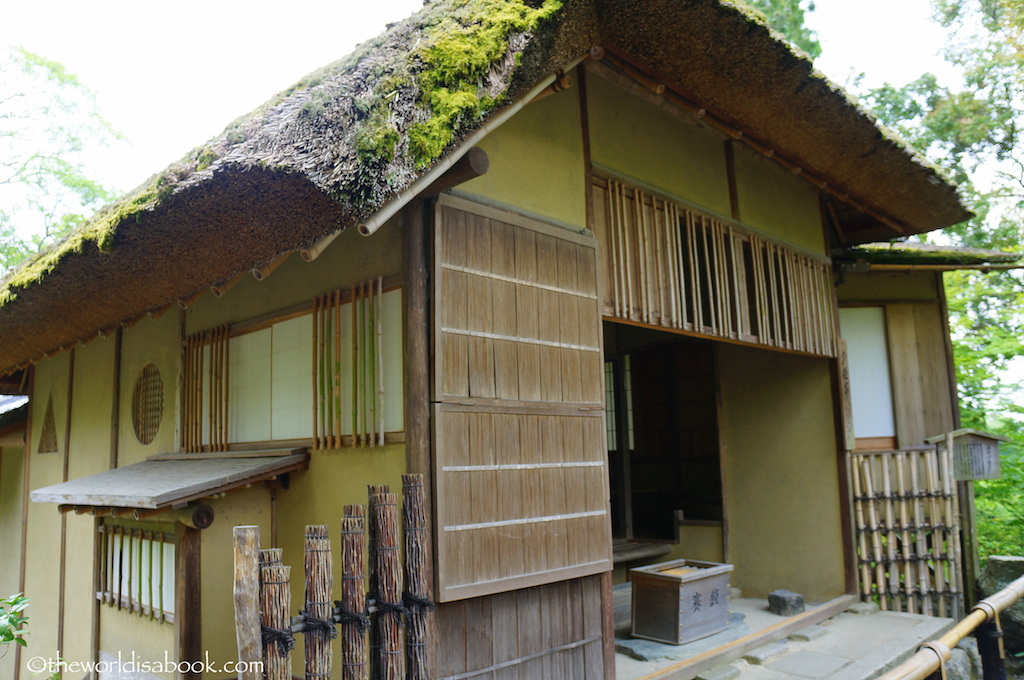
They displayed the teahouse like an exhibit. There was a stone lantern and basin and a stool in the front. If you look deep enough inside, there’s a crooked pillar made of rare Nandin wood that supports the alcove. This was a rare size for this tree that grows very slowly.

We also came across this tranquil garden setting used for tea and snacks.
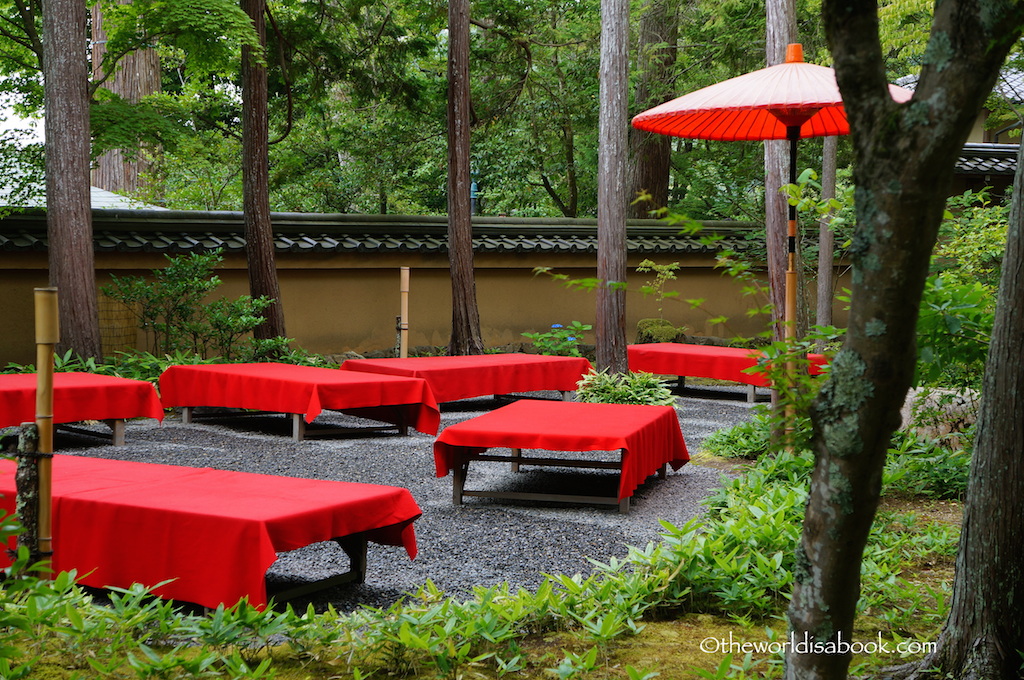
Souvenir Items to buy
Several halls and stalls lined the path towards the exit selling prayer candles and ema prayer tablets (wooden plaques used for leaving wishes).

Fudodo or Fudo Hall was a small shrine that housed Fudo Myoo’s statue (one of the Wisdom Kings and Buddhism protector). It was a popular stop for people to ring the temple bells, light incense and ask for blessings.

The exit of the temple complex was a steep walk alongside trees and a golden wall which seemed fitting.
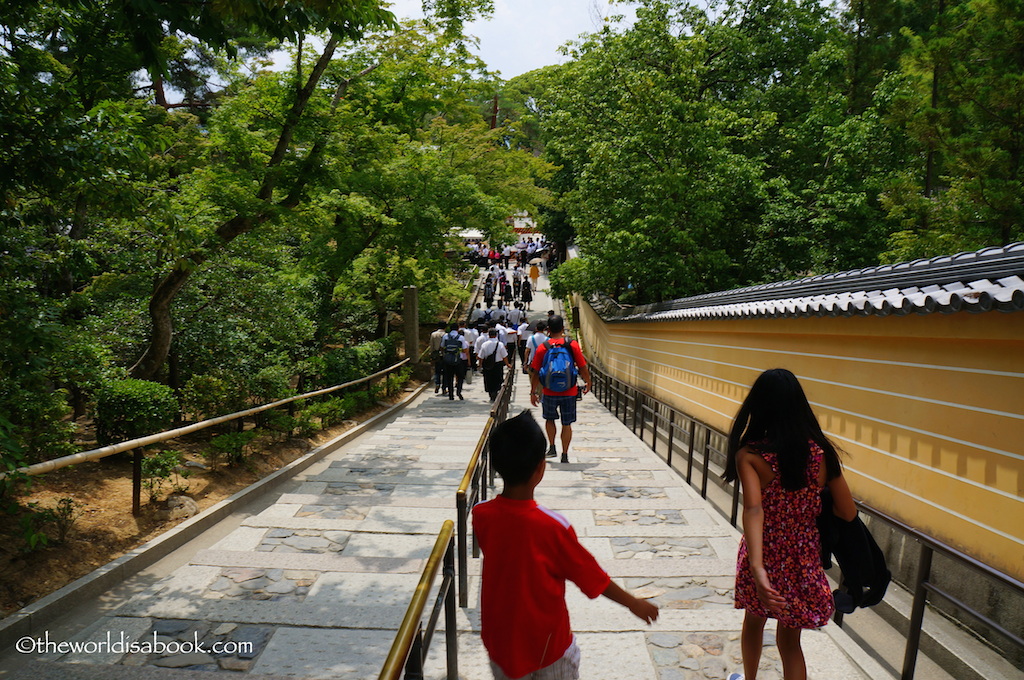
Of course, we couldn’t walk out of here without souvenirs and some treats like cinnamon cookies and sweet treats called yatsuhashi, made of rice flour, sugar, and cinnamon. There were different flavors and the vendors offered samples and chocolate was our winner. Apparently, this is a popular Kyoto treat.

In a city full of temples and reminiscent of ancient Japan, Kinkakuji and its setting in a reflecting pond and garden was one of the most beautiful temples we’ve ever seen. This doesn’t exude a relaxing atmosphere with the number of tourists it attracts.
But, it is a spectacular sight, in addition to its paths and structures. Do not miss this temple no matter how short your time in Kyoto.
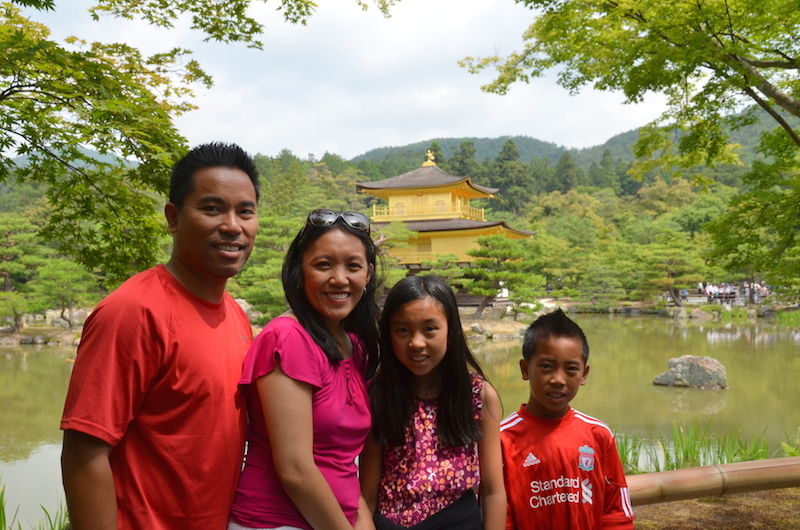
Tips for Visiting the Golden Pavilion Kyoto
- Admission price: 500 yen
- How to get here: We purchased the Kyoto daily buss pass from the visitors center inside Kyoto station and took the bus here. It was a short walk from the bus stop. Kyoto City Bus number 101 or 205 took about 40 minutes from the Kyoto station. Check the Golden Pavilion website for updated transportation options.
- It’s also accessible through the Karasuma Subway Line to Kitaoji Station from Kyoto Station and takes about 15 minutes and then take a bus or taxi.
- There are plenty of vending machines towards the exit for drinks and ice cream.
- It’s not a very big complex and one should probably allocate about 60-90 minutes here depending on the crowds and how closely you want to examine the structures or pleasantly stroll around the gardens.
Have you strolled the grounds of the Golden Pavilion?
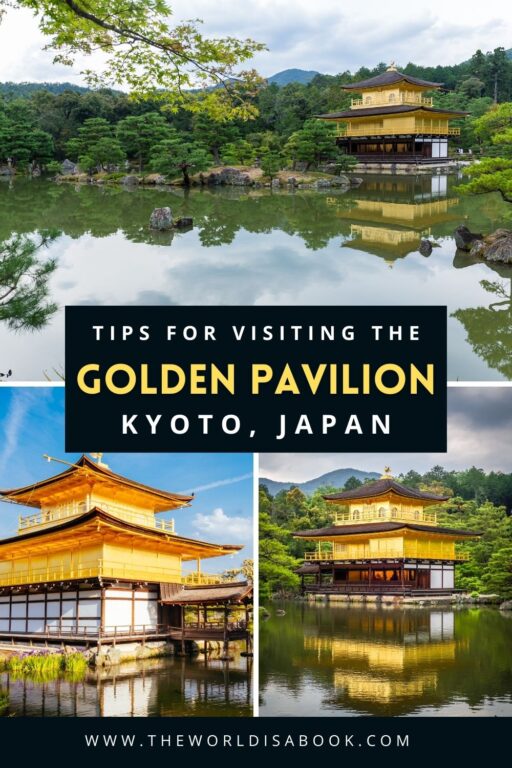
As usual I read your post thoroughly. I can imagine how exciting such a visit would be. Sometimes crowds make things even more exciting. Good on you for getting such good photos with all of the people. Our kids would have loved throwing coins too.
Thanks Jan! It was an exciting visit and one we’ll always remember.
Looks like a must visit place when one is in Japan, the traditional architecture is extraordinary and the atmospheres seems so calm and relaxing.
It was very calm and relaxing if you can block the crowds :-) But, it is definitely a must visit place.
Great photos… I love this place too…
Thanks Lili! I’m glad this one has your seal of approval.
We also visited the Gold Pavilion in Kyoto while we were there last month. Although the pavilion itself was nice (but much smaller than I had imagined), and the garden beautiful, it was probably the temple in Japan that I liked the least. It was just too crowded with tourists (mostly Japanese tourists), everybody fighting and shouting to get the perfect selfie in front of the lake with the pavilion. The atmosphere was not that nice, and not Zen at all! :)
I know what you mean about all the tourists. There were a lot of school kids when we were there so it was a bit loud. It really took the calmness out of the whole place. I’m glad you got to experience it too.
Two thousand temples? Wow, that is quite a lot to choose from. Even without the gold, this one would have been a beautiful. The setting is stunning. I can see why you say it shouldn’t be missed. Thanks for the tour, Mary!
I’m glad you enjoyed the tour, Marcia. I know..it was staggering to find out how many temples there were. The setting really is beautiful.
What a gorgeous family photo, Mary! I would never have known that this site was crowded with tourists – you did an amazing job of framing the photos and capturing a peaceful feeling! The yatsuhashi sounds delicious – I love anything cinnamon-flavoured!
Thanks Lisa! I also chose to put photos without the people ;-) One just needed to be patient to get these shots. The yatsuhashi were so delicious and so were the cookies.
Aww, I love this! I have always wanted to visit. Lovely pictures, as always. Thanks for sharing!
Happy travels :)
Thanks Lauren! I hope you get to visit Kyoto soon.
Up until the last year, a visit to Japan had never made the top 10 on my travel wish list. But the more I read about it, the more I want to visit. Your photos are stellar and it looks like a great family outing, even in the heat.
Thank you, Leigh! I’m glad Japan is moving up on your list. It’s such a beautiful country and I know you’ll enjoy it.
What a stunning place! The gardens all look so peaceful and serene. Thanks for sharing!
What an utterly beautiful temple this must have been to visit (regardless of the tourists)! They’ve done an immaculate job of keeping it preserved. We would love to visit one day too. Love the pictures!
Interesting place! Nice shots.
I haven’t researched much about Japan, but the more I see photos of Japan, the more it makes me want to go. Thanks for the background on this location, and the practical travel tips, and good to see you on #weekendwanderlust!
Katie
It looks like you guys are having a great time! I spent several months in Japan for work years ago and while I made a quick trip to Kyoto, I didn’t get to see the Golden Pavilion. Guess I’ll have to go back ;)
Your photos are so serene. The tea house was my favorite part because it was so simple and quaint. It amazes me how many times this temple has been rebuilt. I wonder if they dig through the remnants to salvage the gold.
Mary, I went to the Golden Pavilion with a bunch of girl scouts from Alaska. It was a steamy day when we went as well. I was disappointed that you can’t go inside. I loved the grounds, and your photos are stunning. Thanks for linking up with Weekend Travel Inspiration!
Beautiful photos, Mary! I loved the Golden Pavilion when I visited Kyoto 8 years ago but I remember it was quite difficult to take good photos and dodge all the other tourist pushing into you and getting into your shots. Well done!
What a fabulous find for just $5, the colour and shape of Kinkakuji (spelling is stunning!
These Japanese structures never cease to amaze me: a simple and still so intricate design. Very beautiful description of the Golden Pavilion in Kyoto. It’s wonderful that you can expose you kids to all these beautiful places.
Your pictures are absolutely amazing. I can only hope to visit Japan someday.
(Found you through SundayTraveler)
Funny how the gold leaf looks plain yellow from a distance, but I can really see why you were fascinated with this temple and the surrounding gardens. So much Japanese history and culture captured in one place.
We visited last year, and it’s so beautiful. The Pavilion itself has such an interesting (recent!) history, and it’s really hard to photograph, but you have done a great job! :)
Hi Mary, great job on the photos. Without the crowds in sight, the temples and its surrounding looks very tranquil. I haven’t been here. It so beautiful and looks definitely worth visiting despite the thick crowds. As I always say, there’s always a good reason why a place is touristy. It was nice that the there was some thing fun for the kids to do. I didn’t expect to find such fun in a temple myself.
This place looks so amazing! I’m surprised that when you said there were a million people there, you can hardly tell from your photos – it looks so calming and serene. Thank you for sharing and linking up with #WeekendWanderlust!
Beautiful images! And only $5 (US). Sounds like a bargain!
Hi it’s Christa, host of the Sunday Traveler, I just wanted to pop in and say thanks for joining in on the fun! Stunning photos. I love how you were so honest and shared your journey. It is a breathtaking place and a once in a lifetime experience for sure!
This was one of my favorite places in Kyoto though it was a bit crowded. It is surreal to watch that Golden Temple shimmering in that beautiful lake! Ah! This post made me nostalgic, thanks for reviving happy memories Mary :)
I love the reflection of the pavilion in the water! It looks so nice and peaceful.
Hi Mary! You bring back a lot of great memories. This was definitely one of my favorite spots when I visited Kyoto. If I remember correctly it was extremely quiet the day I was there (lovely!). I think it had something to do with the 40+ summer heat!
I’m looking forward to visiting Japan one day. I’ll definitely have to go see Kyoto now and their amazing temples. Thanks for linking up to #WeekendWanderlust.
What a great place Kyoto is and I have never seen it without snow, it is still beautiful.
Hi Mary, this post was so beautiful, the pictures and the description make it sound like the most interesting and peaceful place. I’d love to visit Japan one day, you’ve just made me want to go more!